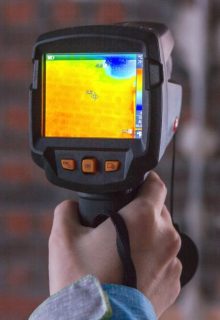Energy & Fabric Performance Evaluation

Many projects have a ‘performance gap’, which is the difference between design stage and as-built performance. Understanding the extent of this gap is vital for reducing costs, ensuring good quality construction, and providing feedback and recommendations for future projects.
Part L (2021) of the Building Regulations introduces a requirement for photographic evidence to be provided for each dwelling as a record of the construction quality. The aim of this is to reduce the performance gap and hence make sure buildings are fit for purpose. We can build on this with further analysis at the as-built stage, typically for a sample of dwellings early on in the scheme to be able to inform the construction team of any potential defects.
As-built energy and fabric assessment comprises two stages of evaluation, pre- and post-occupation:
- Pre-occupation
- Thermal imaging
- Heat flux testing
- Co-heating assessment
- Air tightness testing
- Post occupation
- Monitoring dwelling energy consumption
Our energy and fabric assessment is useful for problem solving. We provide feedback to aid the design of upcoming projects and phases, optimise performance and avoid over- or under-specification.